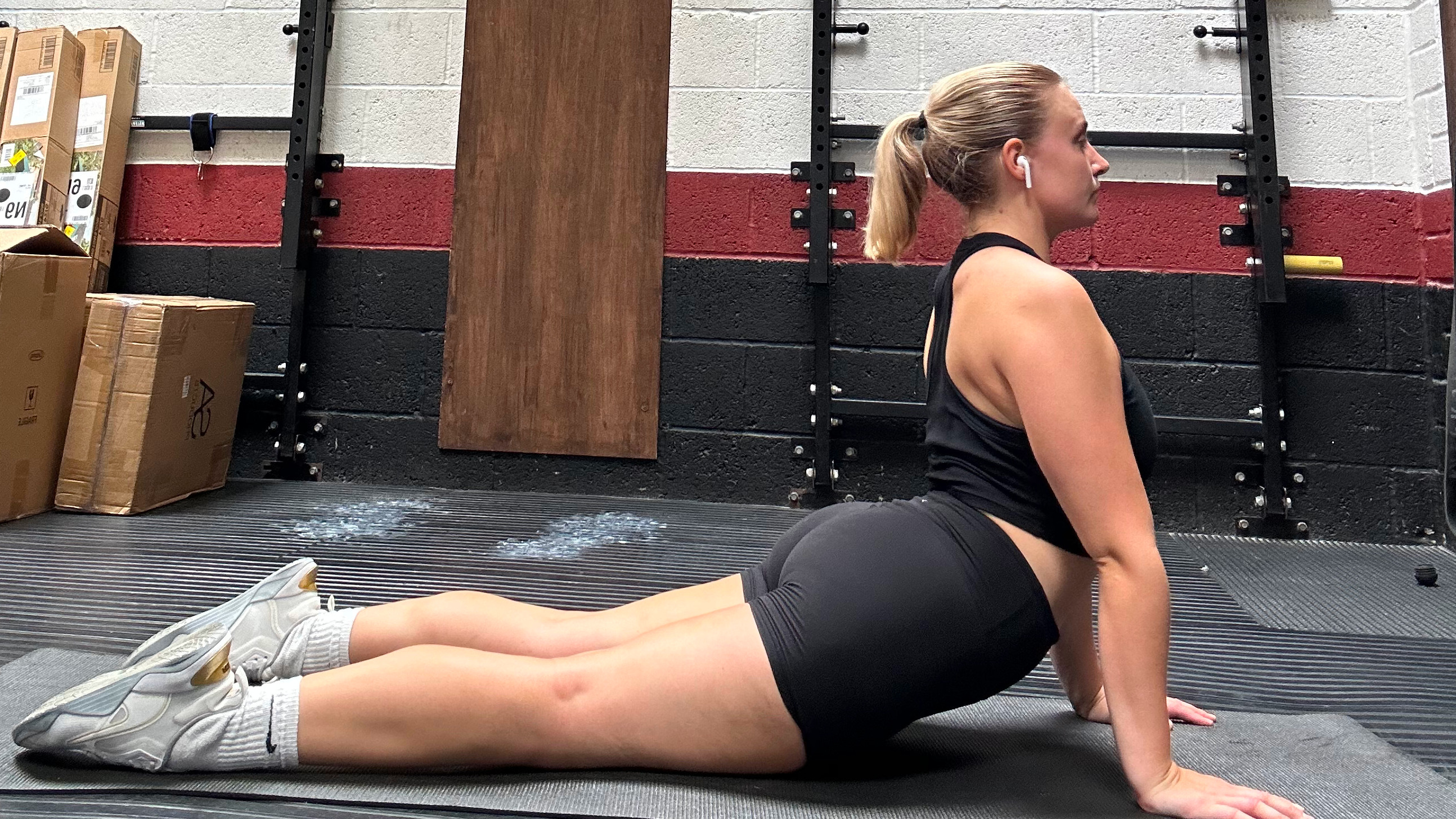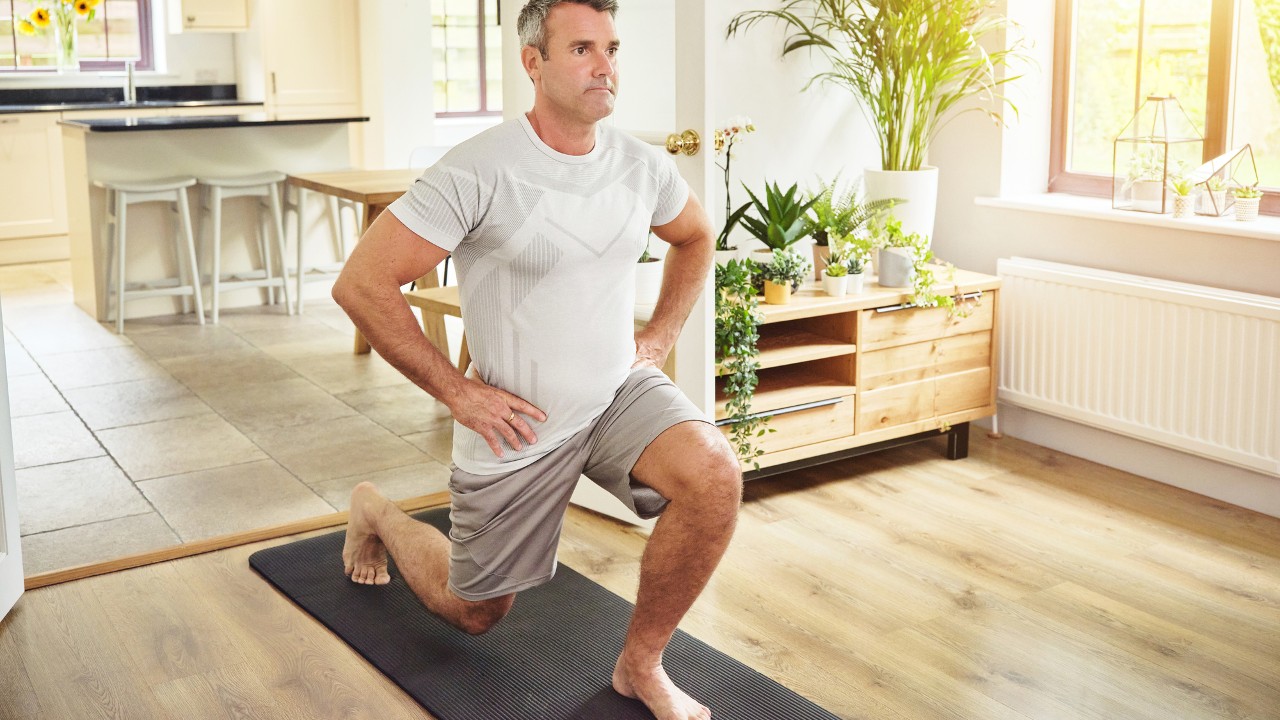The Bodyweight Workout That Builds Big Muscles
Never wait for the squat rack again – use this bodyweight workout from top trainer Sean Bartram to grow
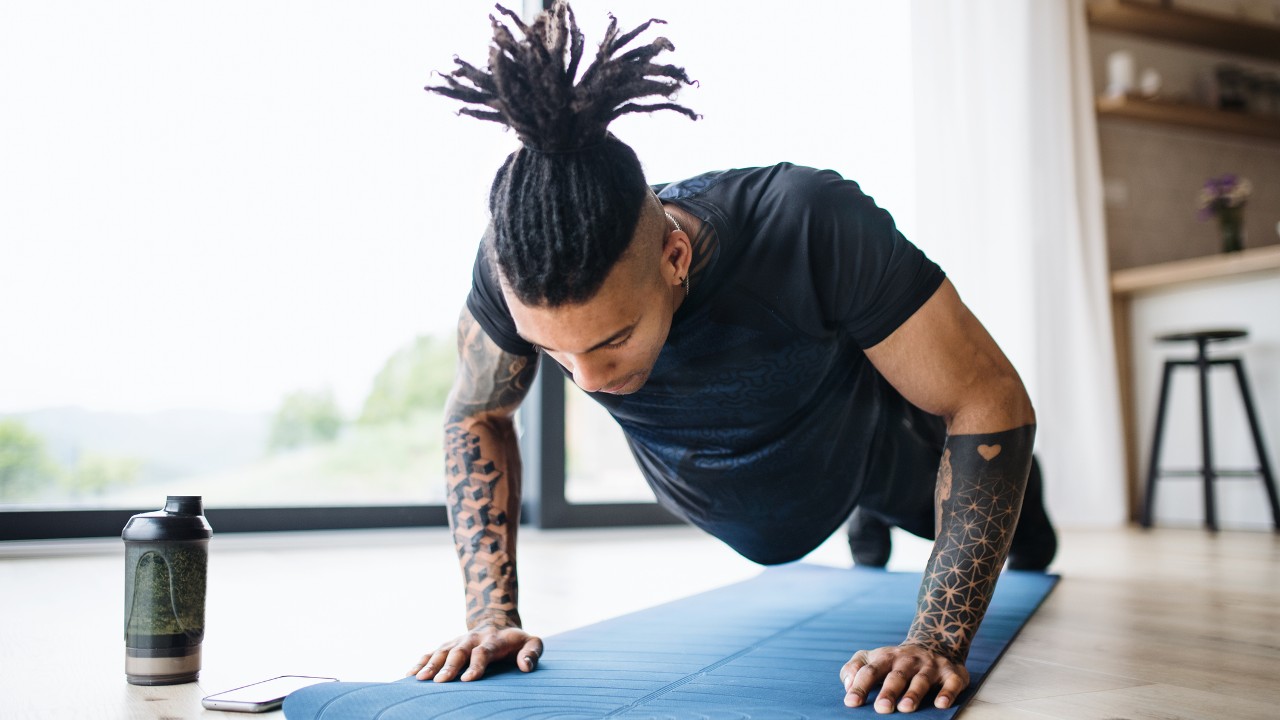
People who believe that you have to wield heavy weights in order to build big muscles have simply never used their body in the right way. Get creative with your bodyweight workouts and you can lose fat, get fitter and bulk up without ever having to touch a weight plate or dumbbell.
Below you’ll find an in-depth explanation of how to use bodyweight training to build muscle, provided by the experts at Ultimate Performance, and three bodyweight workouts that demonstrate the truth of those words. The workouts are all designed by bodyweight training master Sean Bartram, who’s an author and former trainer for the Indianapolis Colts cheerleaders, helping them to develop show-stopping gymnastic power.
“Think of your body as an empty barbell,” says Bartram. “Changing the pace you move it with, holding awkward positions, adding instability and shaking up classic moves you’ve done all your life serve as the 20kg weight plates you load it up with.”
The advantages of working with just your bodyweight include being able to train anywhere without lugging equipment around, and increased body awareness. You’ll never have to worry about queues for the bench press or squat rack again either, which we reckon is reason enough to switch to bodyweight workouts.
That said, one piece of equipment you will need to complete the workouts below is a pull-up bar. The pull-up may be a bodyweight exercise but it’s not easy to do them without a dedicated bar, unless you happen to have a tree with an ideally-shaped, perfectly-positioned, weight-bearing branch in your garden. If you only have one piece of gym equipment in your home a bar is a solid choice and fortunately pull-up bars are both affordable and there are options to suit all domestic arrangements. If you are in need of one, our round-up of the best pull-up bars helps to narrow down your options and here are today’s best deals.
If you don’t have a pull-up bar and would prefer a simpler, one-off bodyweight workout rather than a series, then we have several great options for you below as well.
Bodyweight Workout Plan To Build Muscle
Bartram’s athletes – especially cheerleaders – must be able to throw their bodyweight around with ease, but not every exercise is done at high tempo. This bodyweight workout plan slows the pace down with pauses, increased range of motion, decreased stability and variations on classic moves to keep your muscles challenged. The result will be functional muscle you never thought you’d own.
If tempo is a new concept to you, find out more with our guide to tempo training in the gym.
There are three full-body workouts to spread across the week. The first four moves each day use timed reps called EMOMs (every minute on the minute) or slow tempos that force you to do high reps and keep the muscles under tension. The last two in each bodyweight workout will spike your heart rate to keep you burning calories.
Bodyweight Workout 1: Range And Tempo
Shake up the pace to amplify your muscles
1 Deep squat
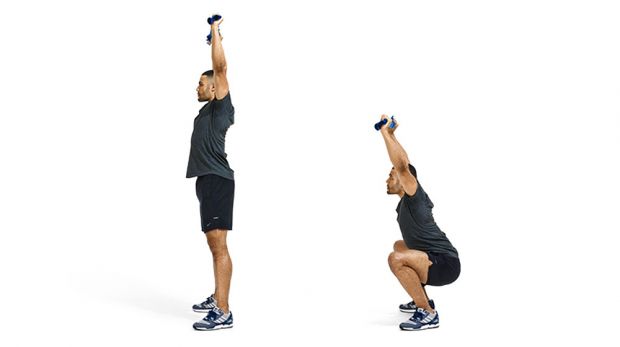
Time 10min EMOM Reps 15
Hold a towel overhead with your arms straight and keep it taut. This will force you to keep your chest up and improve your form. Bend your legs to lower slowly, keeping your knees wide apart, until your hamstrings touch your calves. Then drive back up slowly. Set a timer for ten minutes. Do 15 reps at the start of each minute, and rest for the remainder of each minute. This keeps your heart rate high for more fat loss.
2 Bulgarian split squat
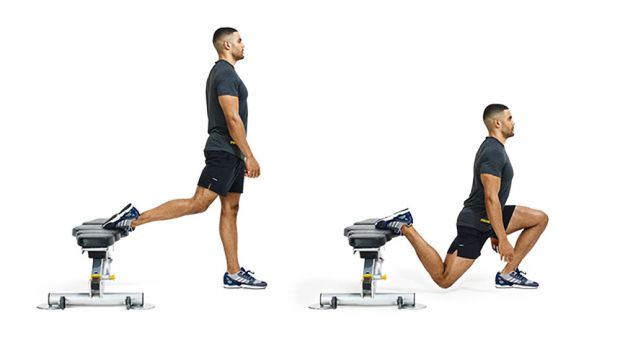
Sets 5 Time 60sec Reps 60sec
Think of this as a lunge with your foot elevated for an extra stability challenge. Put one foot, laces down, on a bench behind you and the other in front. Bend your front leg to lower your body, then drive back up. Keep your body upright throughout and your front knee in line with your toes.
Vary the tempo with each set of these split squats so your muscles are under load for long muscle-building spells. Below is how it breaks down. The first number is the seconds the lowering part should take, then how long you pause for, then how long you take to drive up. The fifth set is max isolation, holding the deepest position for the whole minute.
| Set | Lowering | Pause | Drive up |
|---|---|---|---|
| Minute 1 | 3sec | 1sec | 1sec |
| Minute 2 | 1sec | 3sec | 1sec |
| Minute 3 | 1sec | 1sec | 3sec |
| Minute 4 | 2sec | 0sec | 2sec |
| Minute 5 | - | 60sec | - |
3 Squat jump with floor touch
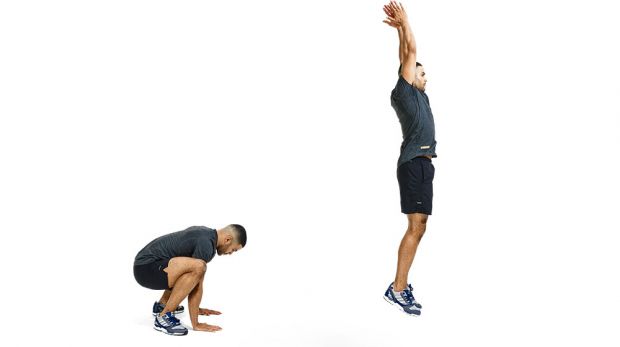
Sets 3 Reps 15
Bend your legs, keeping your knees wide apart and your heels in contact with the floor, to drop into a deep squat. Place your hands lightly on the floor and pause for two seconds, then drive up off the floor powerfully, clapping your hands together overhead. The two-second pause removes any rebounding effect to help you build greater strength in the deep squat position.
4 Bridge kick
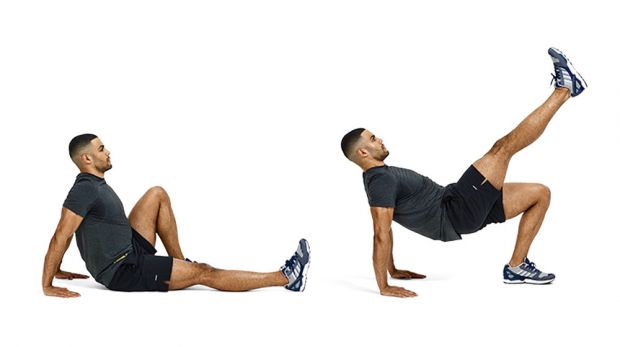
Time 10min EMOM Reps 10 each leg
Sit on the floor with one leg bent, one straight and your fingers pointing towards your feet. Push into the floor and squeeze your glutes to slowly raise your hips until they’re level with your stabilising knee while raising your straight leg until it’s at 90° to your torso. Slowly lower to the start. Complete all the reps on one side, then switch.
5A Press-up burpee
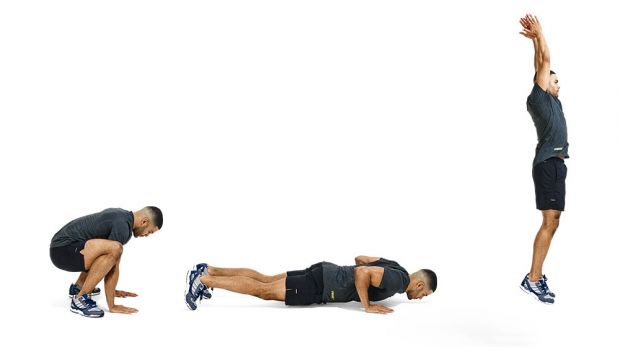
Sets 10-1 ladder
From standing, drop down and place your hands on the floor outside your feet. Jump your feet back and do a press-up, then hop your feet back to between your hands. Jump up, clapping your hands overhead. Do ten reps of 5A, then go straight into ten each side of 5B. Then nine, eight and so on, resting as needed.
5B Jump lunge
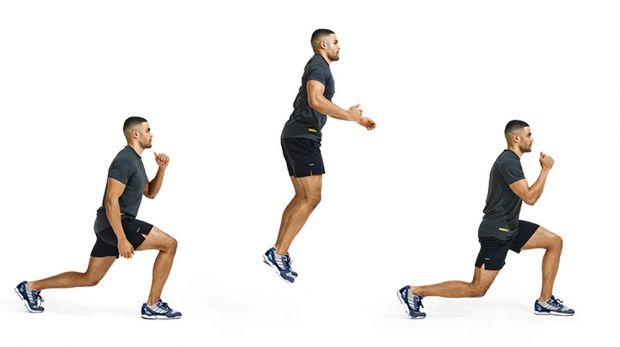
Sets 10-1 ladder
Start in a forwards lunge position with your arms out for balance. Jump off the ground by driving up with your front leg. Swap your legs over in mid-air so you land with the other leg forward. Alternate legs for each rep.
Bodyweight Workout 2: Points Of Contact
Shift your grip and stance on classic moves for upgraded gains
1A Spider-Man press-up
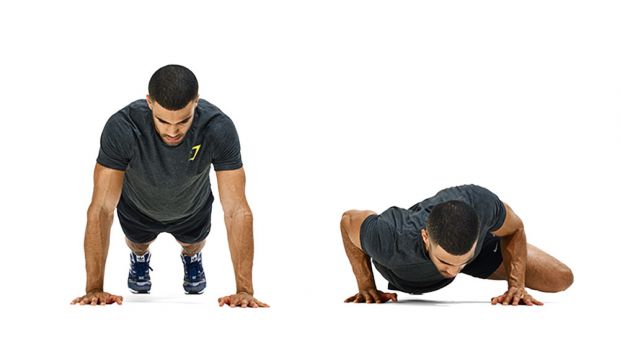
Sets 4 Reps 20/10/5/1
Start in the top of a press-up position. Bend your arms to lower your chest until it’s just off the floor and simultaneously bring one knee up to your elbow, then return to the start. Alternate knees. When you’ve completed the reps, go straight to 1B without resting. On the final single rep, make this super-slow – do it over a ten count.
1B Wide-grip pull-up

Sets 4 Reps 15/10/5/1
Grasp a bar with an overhand grip so your palms are facing away from you and your hands are double shoulder-width apart. Contract your upper back muscles and pull your sternum towards the bar. Then lower under control. Rest for 5sec per rep. Same drill on the final rep: take ten seconds.
2 Pike press-up
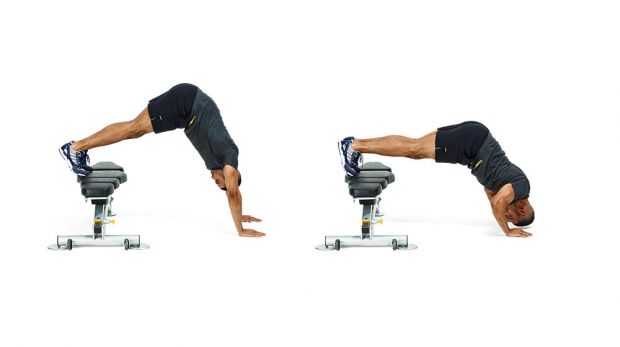
Sets 5 Time 60sec Rest 60sec
Adopt a press-up position with your feet on a bench and your back and arms in a straight line. Keep your head tucked in and bend your arms to lower your head until it’s just off the floor. Push up. Use the same tempo as for the Bulgarian split squat (see below) in Workout 1. Once you can maintain a perfect L-shape with your body throughout, handstand press-ups are in your sights.
| Set | Lowering | Pause | Drive up |
|---|---|---|---|
| Minute 1 | 3sec | 1sec | 1sec |
| Minute 2 | 1sec | 3sec | 1sec |
| Minute 3 | 1sec | 1sec | 3sec |
| Minute 4 | 2sec | 0sec | 2sec |
| Minute 5 | - | 60sec | - |
3 L-Sit chin-up
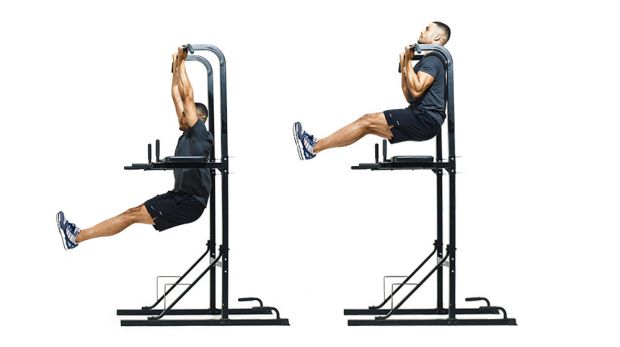
Time 10min EMOM Reps 2
Hang from a pull-up bar with an underhand grip. Contract your core and bring your legs up together until they’re parallel with the floor. From here contract your upper back and pull yourself up until your chin is above the bar. Lower to a dead hang between each rep.
4A Burpee tuck jump
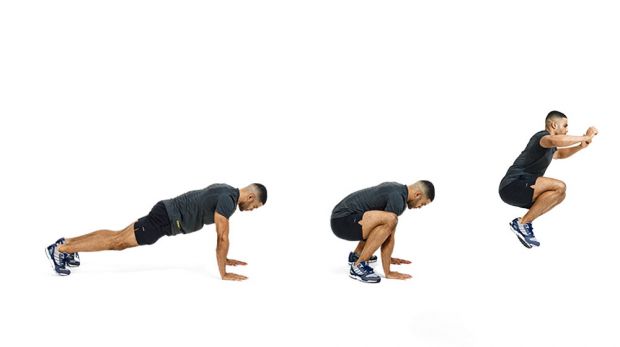
Sets 4 Time 20sec Rest 10sec
Lower your hands to the floor and jump your feet back into the top of a press-up position. Hop your feet back, then drive up to jump explosively. At the same time tuck your knees towards your chest. Bend your knees to cushion your landing and continue into the next rep.
4B Hanging leg raise
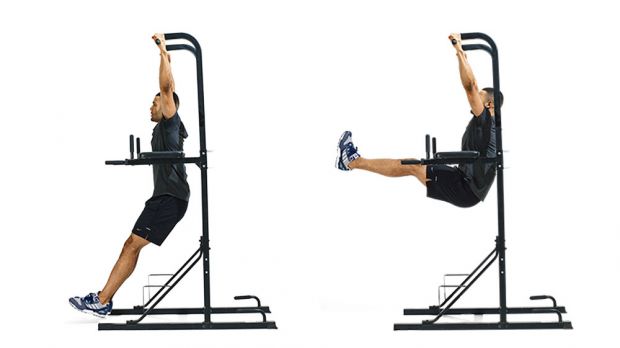
Sets 4 Time 20sec Rest 10sec
Hang from a pull-up bar with an overhand grip and contract your upper back muscles. Contract your core and bring your legs up together until they’re parallel with the floor, then lower them back down to the start. Keep your core contracted throughout to avoid swinging.
Bodyweight Workout 3: Range, Tempo And Stability
Stretch, pause and power up for size and strength
1A Shrimp squat
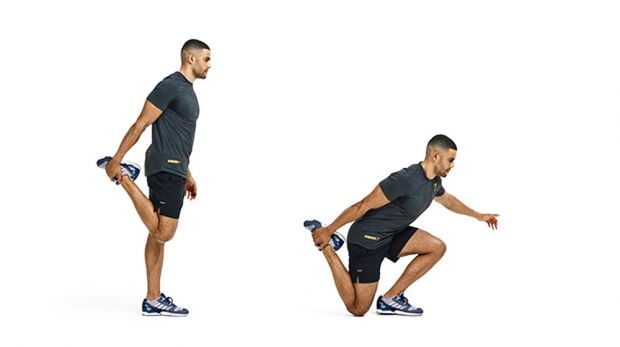
Sets 4 Reps 10/5/3/1
Stand tall and grab one foot with the hand on the same side, pulling it towards your glutes. Put your other hand out for balance and bend your standing leg to lower your other knee until it just touches the floor, then drive back up. Go super-slow on the final rep. This is very tough. Make it easier by releasing your foot – or harder by holding your foot with both hands.
1B Dead hang
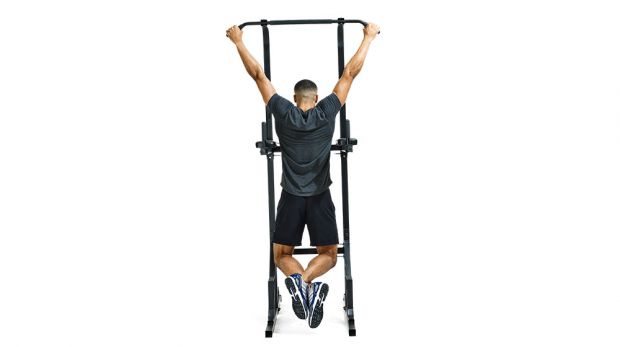
Sets 5 Time 1min
Grab the bar with an overhand grip, palms facing forwards, and let yourself hang fully. This decompresses your spine for improved posture while challenging your grip strength. Add in a gentle swing from side to side or change up the grip – narrow, wide, underhand or single arm – to expand the benefit.
Forcing the body to hold a position under tension reveals any chinks in your armour. Just as the plank exposes any weaknesses in your shoulders, core, glutes and thighs, the dead hang uncovers problems with your lats and your grip. Holding that position for longer is a low-impact strength fix.
2 Wide-grip press-up
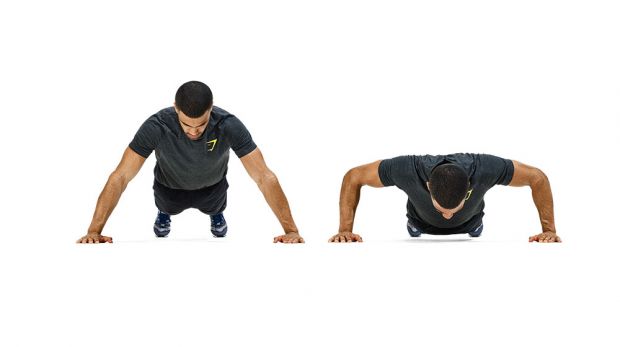
Sets 5 Time 60sec Rest 60sec
Perform a standard press-up but with your arms double shoulder-width apart. Lower your chest until it’s just off the floor, then press back up until your arms are straight. Use the same tempo method that you used for the Bulgarian split squat in Workout 1 (below).
| Set | Lowering | Pause | Drive up |
|---|---|---|---|
| Minute 1 | 3sec | 1sec | 1sec |
| Minute 2 | 1sec | 3sec | 1sec |
| Minute 3 | 1sec | 1sec | 3sec |
| Minute 4 | 2sec | 0sec | 2sec |
| Minute 5 | - | 60sec | - |
3 Straight-arm super plank
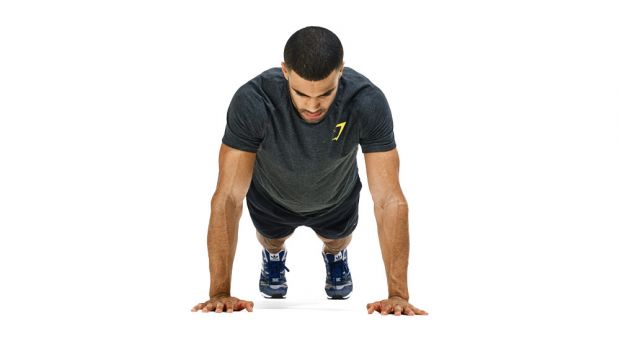
Sets 5 Time 30sec Rest 30sec
Get into a plank with your arms straight and your weight on your hands and toes. Keep your body in line, feet together and upper arms straight down from shoulders. Squeeze every muscle, from your chest and abs to your glutes and calves. You should be shaking at the end of each set.
This is a classic plank with a double twist. Doing it with straight arms works your chest harder, while full tension keeps your heart pumping fast for a fat-loss bonus. Focusing on squeezing every muscle during a move will engage more muscle fibres than just those targeted with the exercise, transforming a low-energy move into a full-body shock to melt away fat.
4A Incline clap press-up
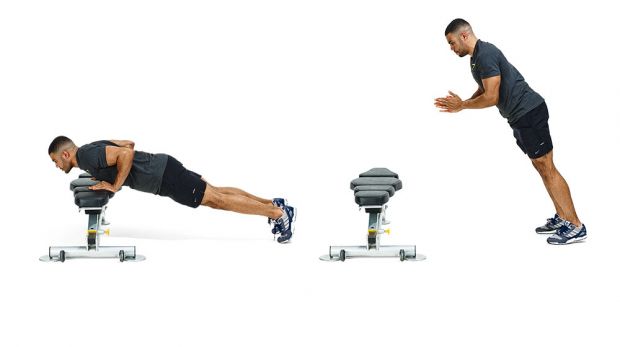
Sets 1-10 ladder
Start in a press-up position with hands elevated. Lower towards the bench, then explode up until you’re almost standing. Clap your hands, put them back out to break your fall and go into the next rep. This reverses the descending ladder in Workout 1 – start with low reps and climb to the top.
4B Burpee to chin-up
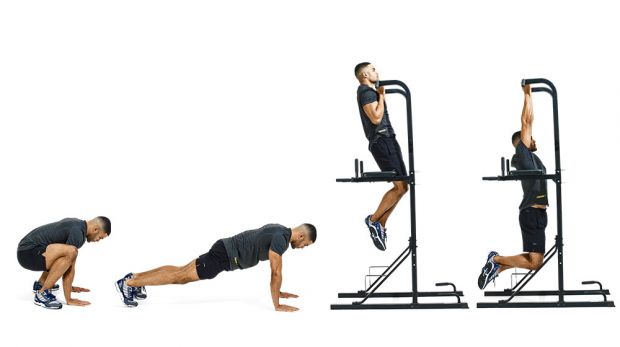
Sets 1-10 ladder
Position yourself under a pull-up bar. Lower your hands to the floor and jump your feet back into the top of a press-up position. Hop your feet back, then drive up to jump up explosively and grab the bar with palms facing you while pulling yourself up into a chin-up. Lower slowly under control, then drop to the floor for the next rep.
Sean Bartram is the author of Bodyweight Workouts For Men and has trained athletes from sports as diverse as IndyCar and American football.
Bodyweight Workouts FAQ
To understand more about the benefits of bodyweight workouts, we spoke to personal trainer Emily Servante, global trainer education manager at Ultimate Performance.
Can you build muscles just with bodyweight workouts?
The short answer is yes, you can build muscles with bodyweight exercises alone, but with the caveat that your muscular gains are more likely to plateau quicker than if you use weights.
The long answer is everyone will respond differently to resistance training, whether you are using bodyweight exercises or weights. Furthermore, what looks muscular to one person might look too skinny to someone else.
What’s the best type of bodyweight training for building muscle?
Bodyweight training has a reputation for being only suitable for building endurance and fat-loss circuits. However, if you know how to manipulate the difficulty of an exercise, you can perform it so you fail within a six-to-12 rep range.
Doing endless sets of 25 press-ups won’t build much muscle. In fact, many well-known bodyweight movements are limited in their muscle-building scope, but you can increase the intensity by slowing down the tempo and/or pausing in certain positions to work the isometric portion of the muscular contraction [when you keep the tension constant].
For example, if you perform a press-up with both feet on a chair, and slow the eccentric [lowering] portion of the movement to four seconds, doing six to 12 reps will feel more difficult. Next time, slow the eccentric portion of that movement to five seconds, then six seconds and so on. Trust me, your chest muscles will grow!
For the unweighted squat, slow down the lowering to create more time under tension. You can also make it increasingly difficult by adding more reps or sets, or having less rest time, etc, each time you perform the move.
Resistance is resistance. It’s about knowing how to make the resistance high enough to trigger muscle growth.
What are the benefits of doing bodyweight workouts?
The greatest advantage of bodyweight training is that it can be done anywhere, any time.
An obstacle stopping many people is reluctance to travel and sign up to a gym. It’s particularly useful for my clients who are on the road a lot with work where they may not have the time to get to a gym, or are stuck in a hotel with a poorly equipped gym.
Bodyweight workouts also keep you honest. With traditional barbell lifts like the back squat and bench press, the quickest way to gain strength is to increase your bodyweight. That is most commonly achieved by lifting heavy weights and being in a calorie surplus. By adding pounds to your frame, your leverages increase, and your performances will increase, giving you an illusion of progression.
On the other hand, if you incorporate bodyweight exercises like the chin-up or dip as indicator lifts into your programme, it keeps you honest. If your bench press is going up, but your chin-up strength is going down, the chances are all you’ve done is get bigger, not stronger!
Bodyweight workouts also help you develop full-body tension and stability and learn how to generate maximal tension through the body, which is an important part of developing strength. When you’re performing exercises like ring dips, press-ups, L-sits or frog stands, your body has to work as a unit to keep form and maintain stability. This will carry over to exercises like the deadlift, where your entire body needs to be working in harmony to lift the load.
There’s also something to be said for building a base level of strength using bodyweight exercises before advancing to a “fancy” training protocol and obsessing over the details. For example, before worrying which direction your pinky finger should be facing on an incline dumbbell curl, you’d probably get more out of increasing your chinning strength from three reps to 10 reps.
Another added benefit of working with bodyweight exercise targets is that it’ll encourage you to drop body fat too. For those who are weaker and just starting out, you can gain a lot of benefit from getting better at bodyweight squats, split squats, lunges, press-ups, inverted rows, chin-ups and dips.
Bodyweight workouts can also help you develop your abs. If you’ve ever worked on rings, or trained front lever and planche variations, you’ll know how sore your abs get the next day. Any time you move your body through space, your core works hard to stabilise and maintain correct alignment through your body. Also, once you’ve developed more advanced abdominal strength through direct work, bodyweight training can serve as an effective means of maintaining it.
Generally speaking, bodyweight training is also safer on the joints than weight training as your body can move through its natural range of motion. That’s also why dumbbell work is safer than barbell work, as your body is less fixed in a certain plane of motion.
What are the downsides of bodyweight training?
Having extolled the virtues of bodyweight training to build muscle, would I recommend that you ditch weight training entirely in favour of bodyweight training? Give up your gym membership and invest in some resistance bands you can use at home? Short answer: no.
Mastery in advanced bodyweight exercises doesn’t happen overnight. It takes weeks, months, sometimes years of practice. While the rewards can be great, the problem is most people are busy and don’t have the time to spend hours working on bodyweight skills. Most people want to achieve a lean and muscular look in the shortest time possible, and training predominantly with weights is the best path to achieve this.
Following on from this point, progressing through bodyweight exercises can also sometimes be hard to quantify. You can tweak the time spent in the eccentric portion of a movement or increase the number of reps, sets etc. However, at some point, you will hit a point where you can’t really make a movement more difficult or challenging without adding significant weight to that exercise.
For example, as useful as unweighted squats can be, there comes a point of diminishing returns, even if you slow the eccentric portion of the lift right down or drastically reduce rest periods. The lift will no longer be challenging enough to force your muscles to grow.
Let’s say you want to build serious – and I mean serious – muscle. We’re talking Marvel superhero levels of muscle. To achieve that look, you need a combination of lifting very heavy weights to trigger maximum hypertrophy, and eating a lot of calories to give your body the fuel it needs to grow and enable you to lift those big numbers.
Unfortunately, if you’re eating a lot of calories and only performing bodyweight exercises, you will almost certainly struggle to make those exercises tough or challenging enough to trigger muscle growth that is proportionate to your calorie intake. And the result will be you get heavier, probably fatter, but nowhere near as muscular as you would if you were in the gym and lifting heavy weights.
Another big problem with bodyweight-only training is the inability to sufficiently stimulate the posterior chain and thigh muscles effectively. To work the posterior chain, nothing beats barbells and dumbbells. Even if you want to prioritise bodyweight training, you should keep some weighted posterior chain work.
The same applies to leg work. While pistol squats are a great exercise, very few people have the required flexibility to perform them safely. Other quad-based movements like split squats, lunges and squats will all require loading eventually for maximum adaptation, so dumbbells and barbells become a necessity.
What do you need to do apart from bodyweight training to build muscle?
You can perform as many bodyweight training sessions as you like, and manipulate the variables as much as you can, but if your diet consists of chocolate, crisps, takeaways and alcohol, I’m afraid to say you’re not going to get anywhere.
The fundamentals of burning fat and building muscle remain the same, regardless of what type of exercise you do. To lose fat, you need to be in a calorie deficit. That is, you need to consume fewer calories per day than you expend. In order to preserve muscle tissue and encourage your body to tap into our fat stores and not our muscle mass, you need to resistance train and consume a diet high in protein, fibrous vegetables and nutrient-dense carbohydrates.
Also, to trigger muscle growth, you need your hormone profile to be functioning well. If it isn’t, that will inhibit your ability to build muscle. To achieve that, you need to focus on other aspects of your life, such as adequate sleep, stress reduction, hydration levels.
Unfortunately, therefore, while bodyweight training can be a very effective way to burn fat and build muscle, if you are not nailing the basics with your diet, fluid consumption, stress levels, quality and quantity of sleep, then you are going to seriously reduce your chances of building a lean and muscular body.
More Bodyweight Workouts
10-Minute Bodyweight Workout
This quickfire, energy-boosting workout involves doing two rounds of three exercises, keeping the pace high and your rest breaks short.
- Jump squat hold (Reps 10)
- Squat kick (Reps 10 each side)
- Plank punch (Reps 10 each side)
See the 10-minute bodyweight workout
Beginner bodyweight HIIT workout
Get started with HIIT using this accessible five-move full-body workout. Work for 50 seconds, then rest for 10 seconds before moving on to the next exercises. One round is five minutes, and you can do as many as you like to fit the time you have available.
- Squat (Time 50sec Rest 10sec)
- Press-up (Time 50sec Rest 10sec)
- Lunge (Time 50sec Rest 10sec)
- Jumping jack (Time 50sec Rest 10sec)
- Crunch (Time 50sec Rest 10sec)
See the beginner bodyweight HIIT workout
Bodyweight back workout
If you’re worried about the state of your back, this short bodyweight session will begin to address those concerns, helping to improve your posture and strengthen the key muscles in your back.
- Cat-cow (Sets 1 Reps 10-15)
- Standing T (Sets 1 Reps 15-20)
- Standing Y (Sets 1 Reps 15-20)
- Seated banded row (Sets 1 Reps 15-20)
- Wall angel (Sets 3 Reps 10)
- Alternating superman (Sets 1 Reps 3 each side)
- High plank (Sets 1 Time 15sec)
See the bodyweight back workout
Bodyweight posture workout
Whether it’s at home or in an office, spending most of your work day hunched over a desk can play havoc with your posture. This workout combines stretches and strength exercises to help you combat the effects of a sedentary lifestyle.
- Cat-cow (Sets 1 Reps 20)
- Bird dog (Sets 1 Reps 10 each side)
- Glute bridge (Sets 1 Reps 20)
- High plank (Sets 4 Time 20sec)
- Superman (Sets 1 Reps 15)
- Half cobra (Sets 1 Reps 15)
See the bodyweight posture workout

Sam Rider is an experienced freelance journalist, specialising in health, fitness and wellness. For over a decade he's reported on Olympic Games, CrossFit Games and World Cups, and quizzed luminaries of elite sport, nutrition and strength and conditioning. Sam is also a REPS level 3 qualified personal trainer, online coach and founder of Your Daily Fix. Sam is also Coach’s designated reviewer of massage guns and fitness mirrors.
Latest about Bodyweight Workouts
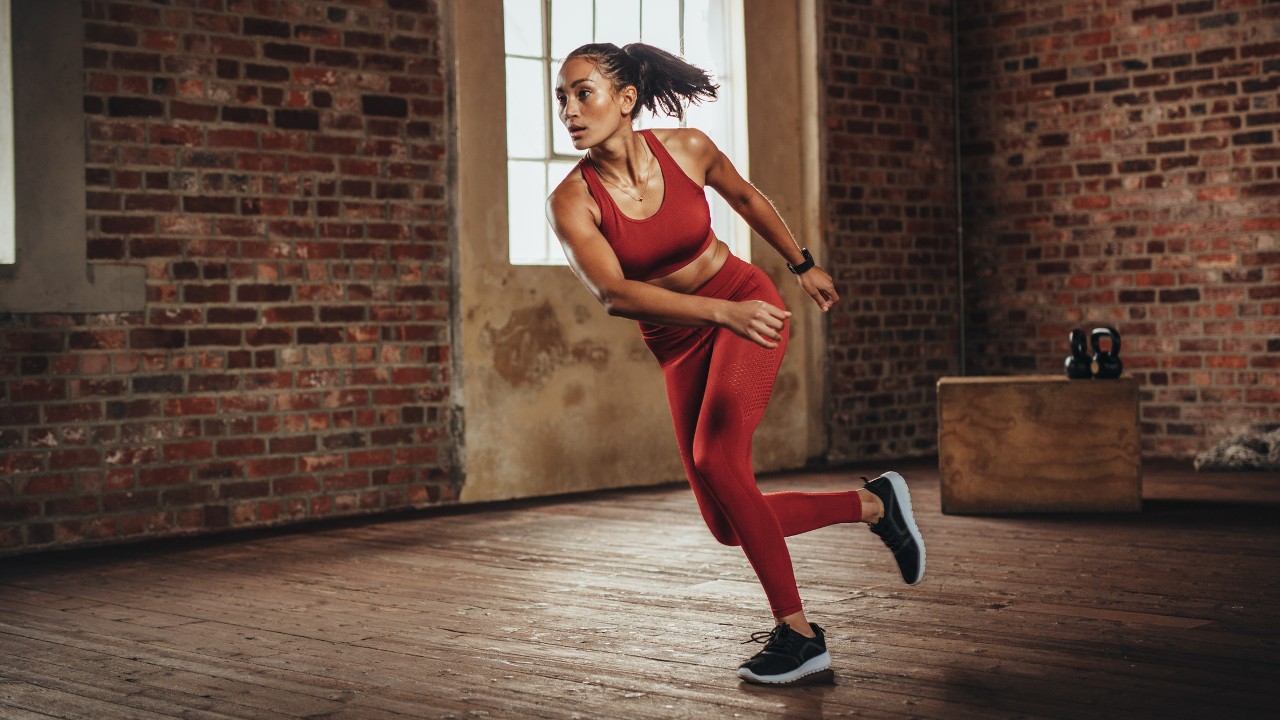
“My Absolute Favorite Thing That I Do With All Of My Athletes”—Finish Your Next Workout With This NASM Trainer’s Leg Circuit
By Harry Bullmore published
Boost leg strength, endurance and cardio capacity with trainer Wendy Batts’ four-move bodyweight workout
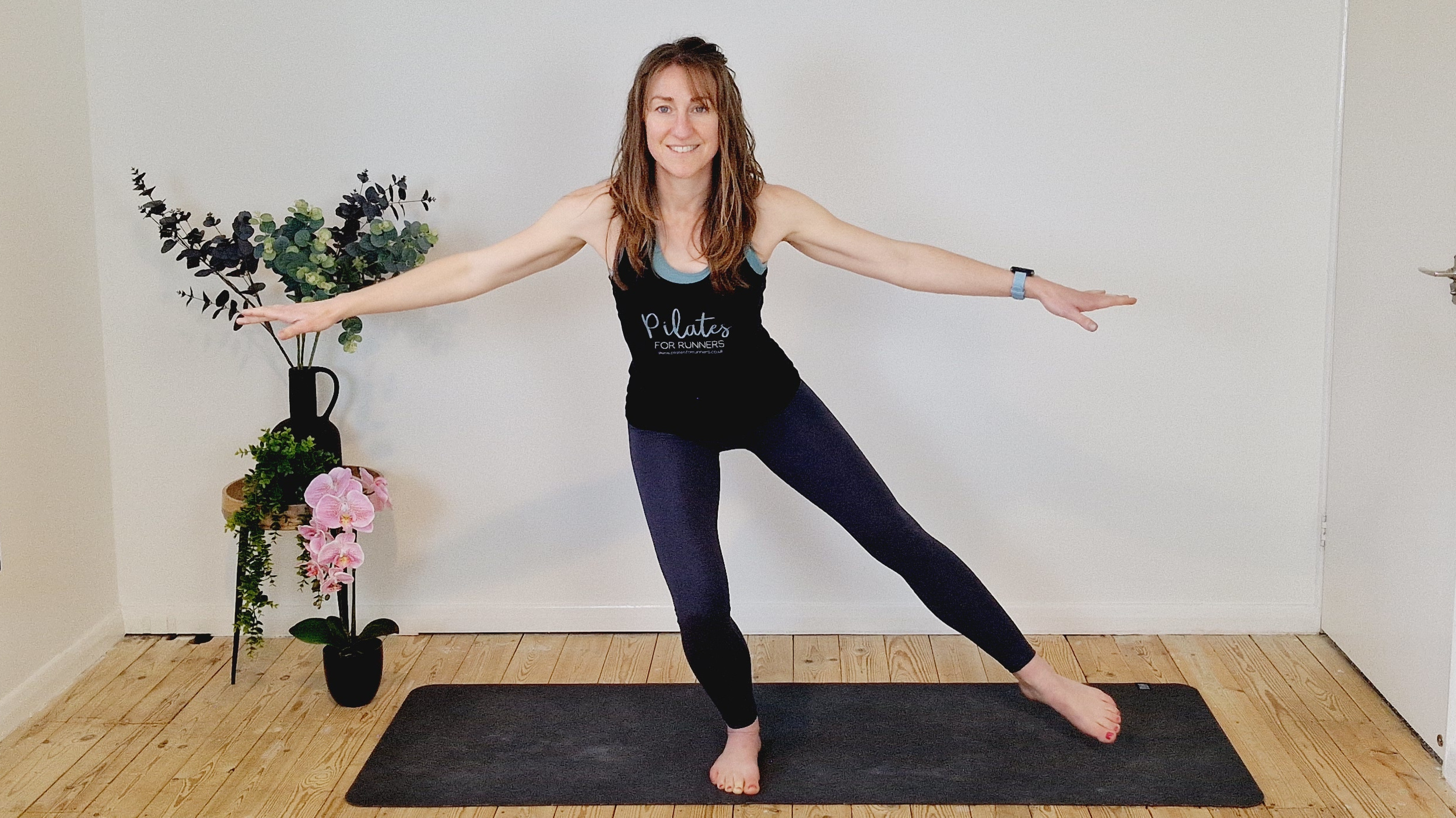
Use This Beginner Pilates For Runners Workout To Improve Your 5K Time
By Nick Harris-Fry published
Try this five-move no-equipment session from the founder of the Pilates for Runners app
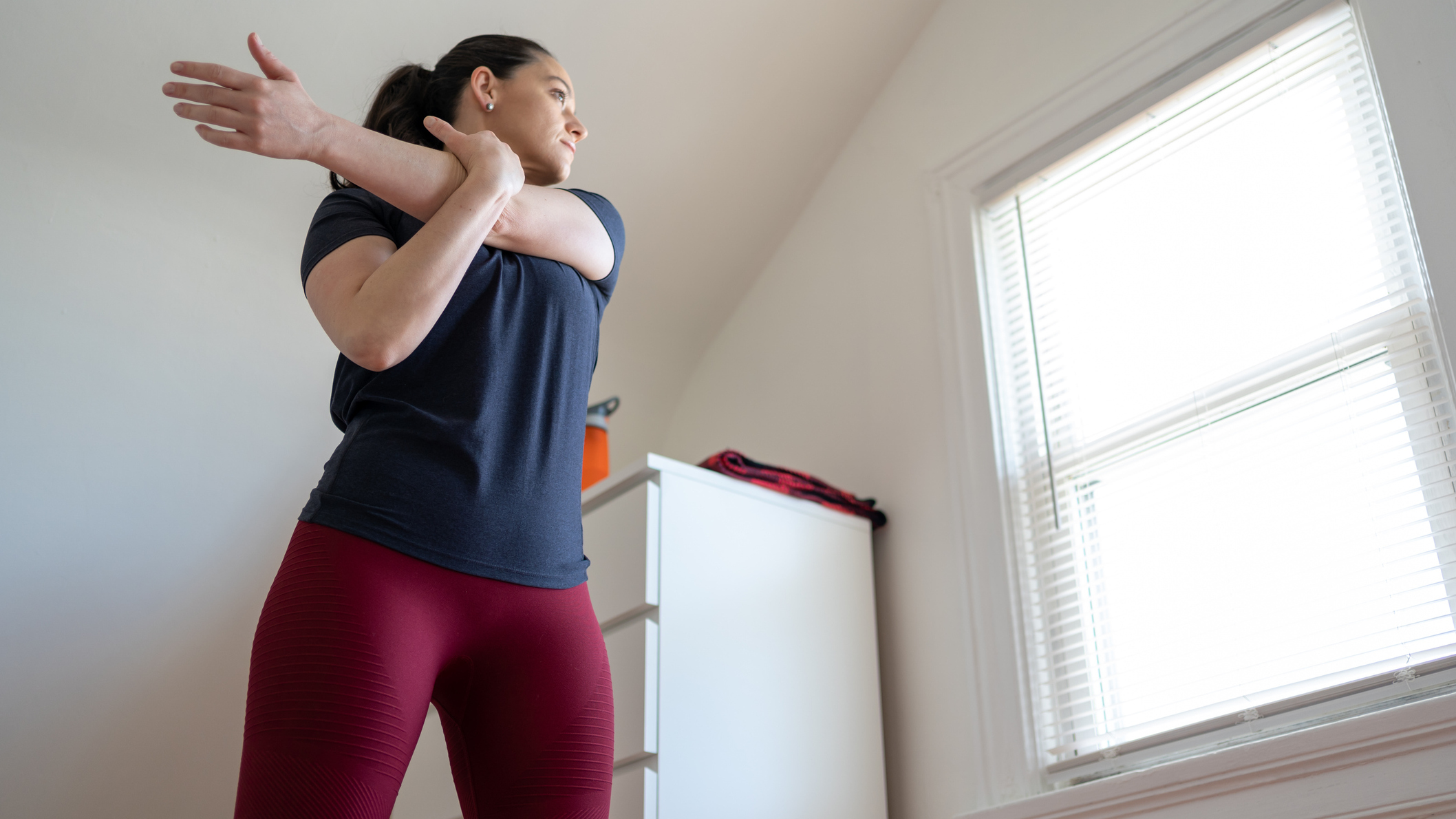
Get Fitter At Home With This Fast-Paced Bodyweight HIIT Workout
By Nick Harris-Fry published
Use this 30-minute bodyweight HIIT workout to get fitter and stronger without any equipment
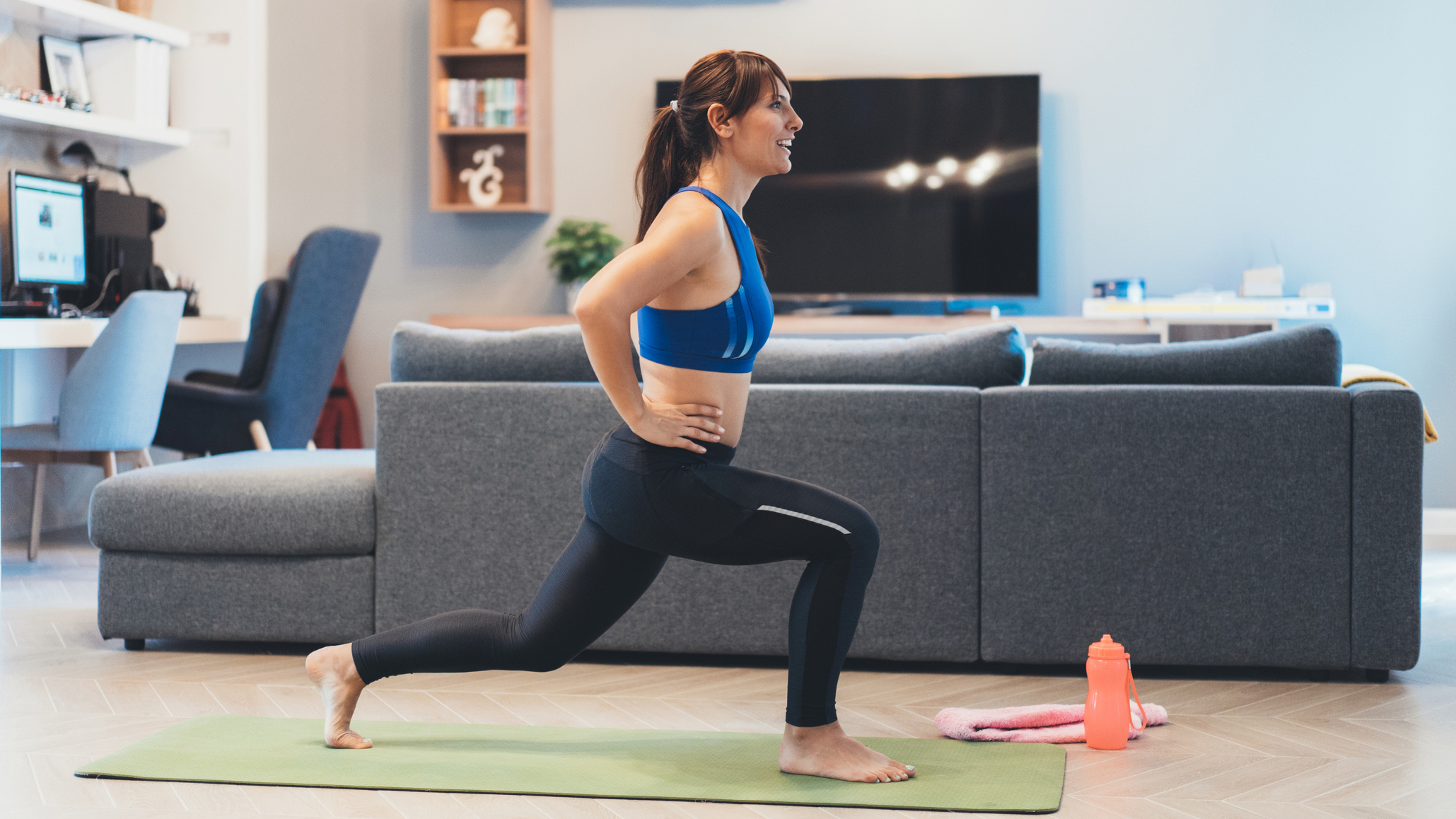
Full-Body No-Equipment Workout To Strengthen The Most Important Muscles
By Camilla Artault published
This PT’s bodyweight workout is especially effective at developing your posterior chain for improved posture and core strength
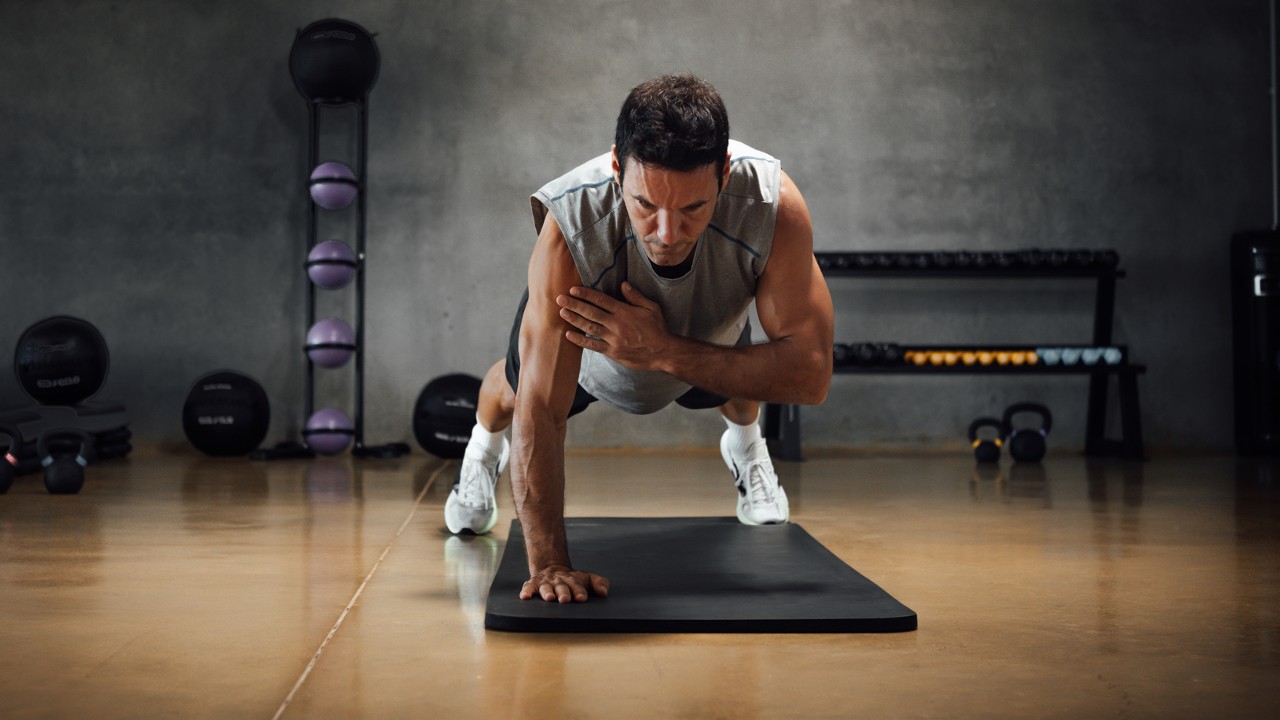
A Bodyweight Shoulder Workout For Healthy, Strong Joints
By Lucy Gornall last updated
Build power in all three primary shoulder muscles with this no-equipment session from an orthopaedic surgeon
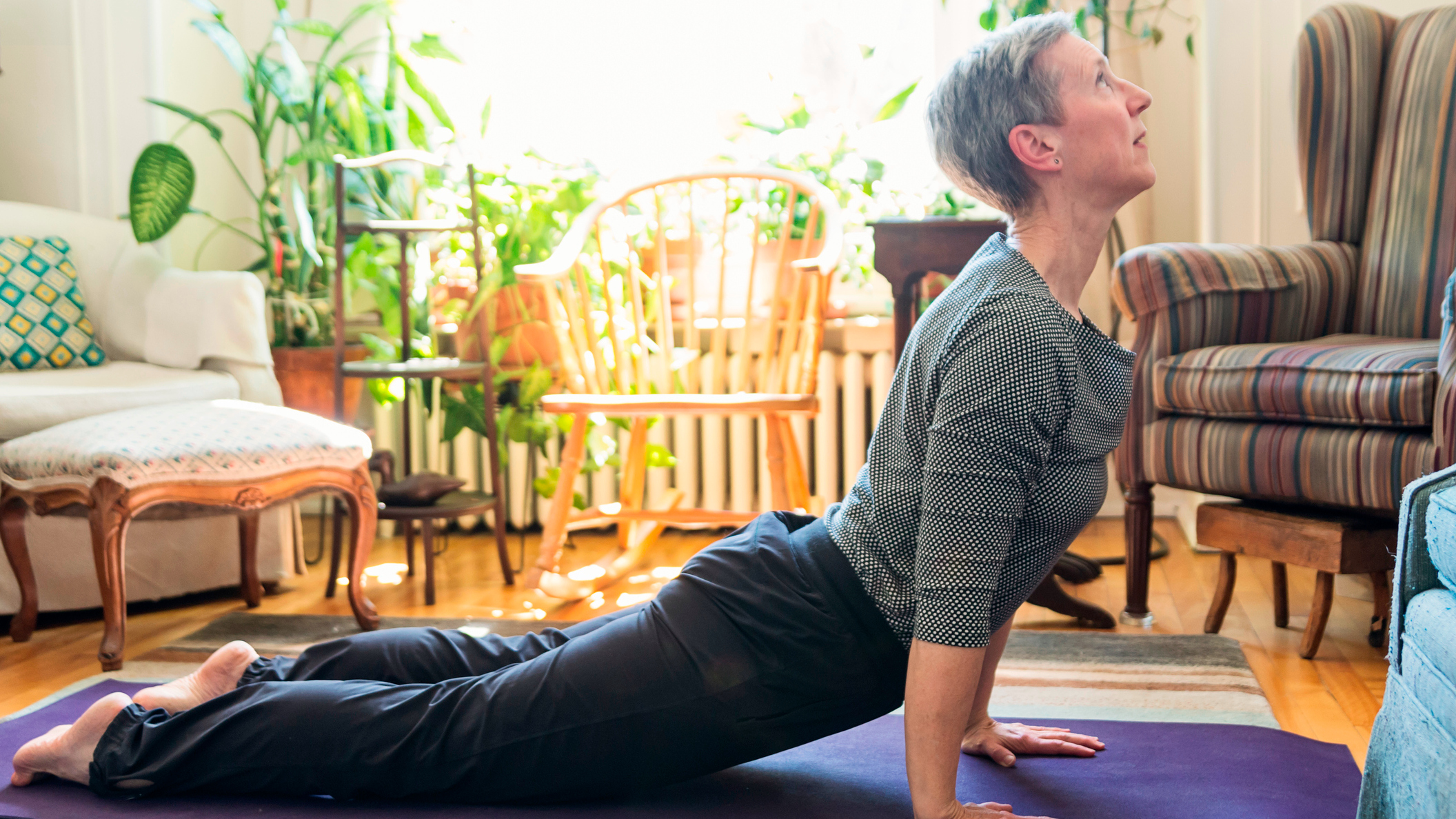
Spending Just 10 Minutes Doing These Four Pilates Moves Can Help You Avoid Back Pain
By Camilla Artault published
Give your back the mobility it needs to stay pain-free
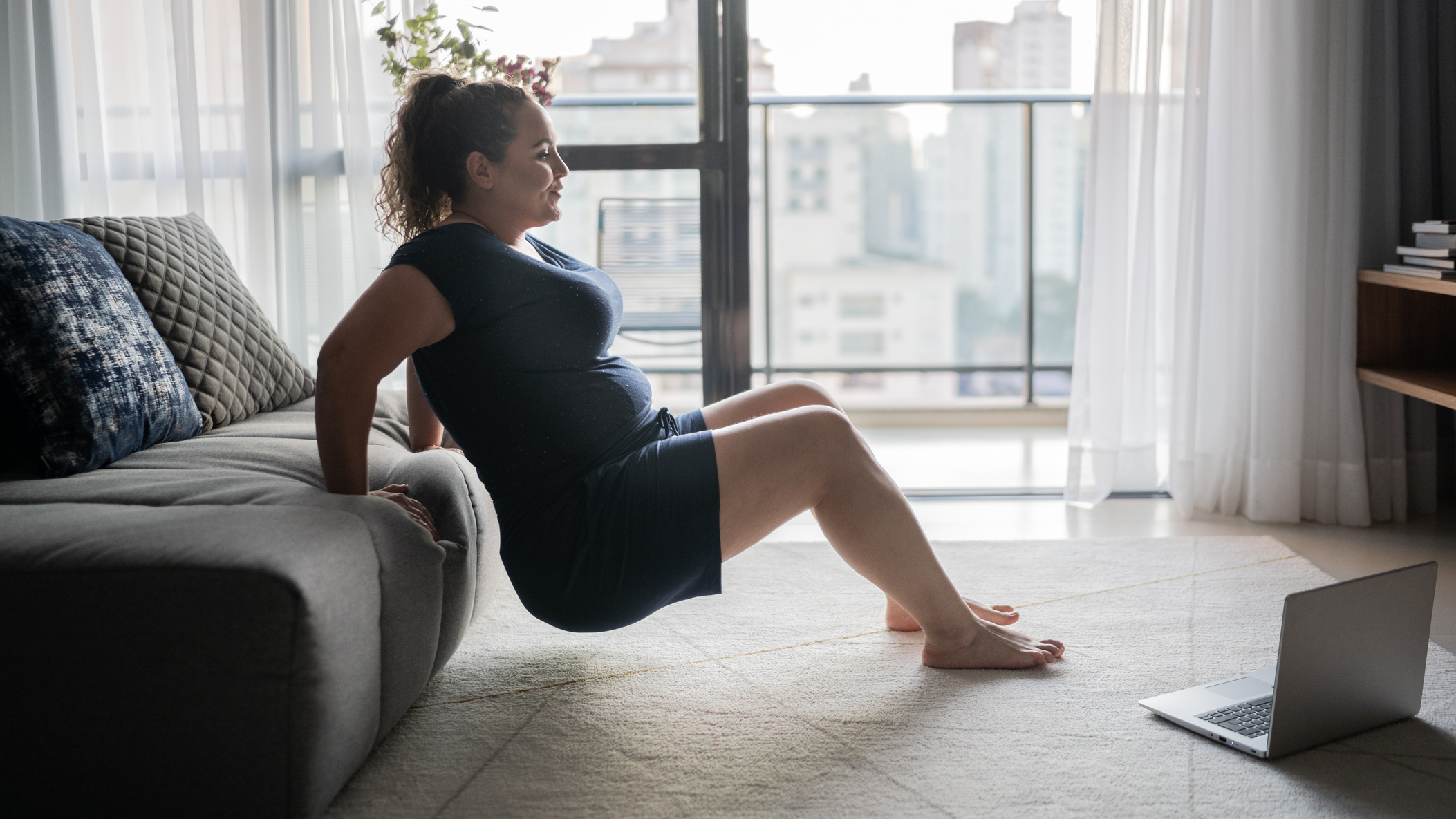
All You Need Is A Bench For This 15-Minute Kayla Itsines Workout
By Camilla Artault published
Whether you’re at home, the gym or a park, you’ll be able to use this five-move routine to work up a satisfying sweat
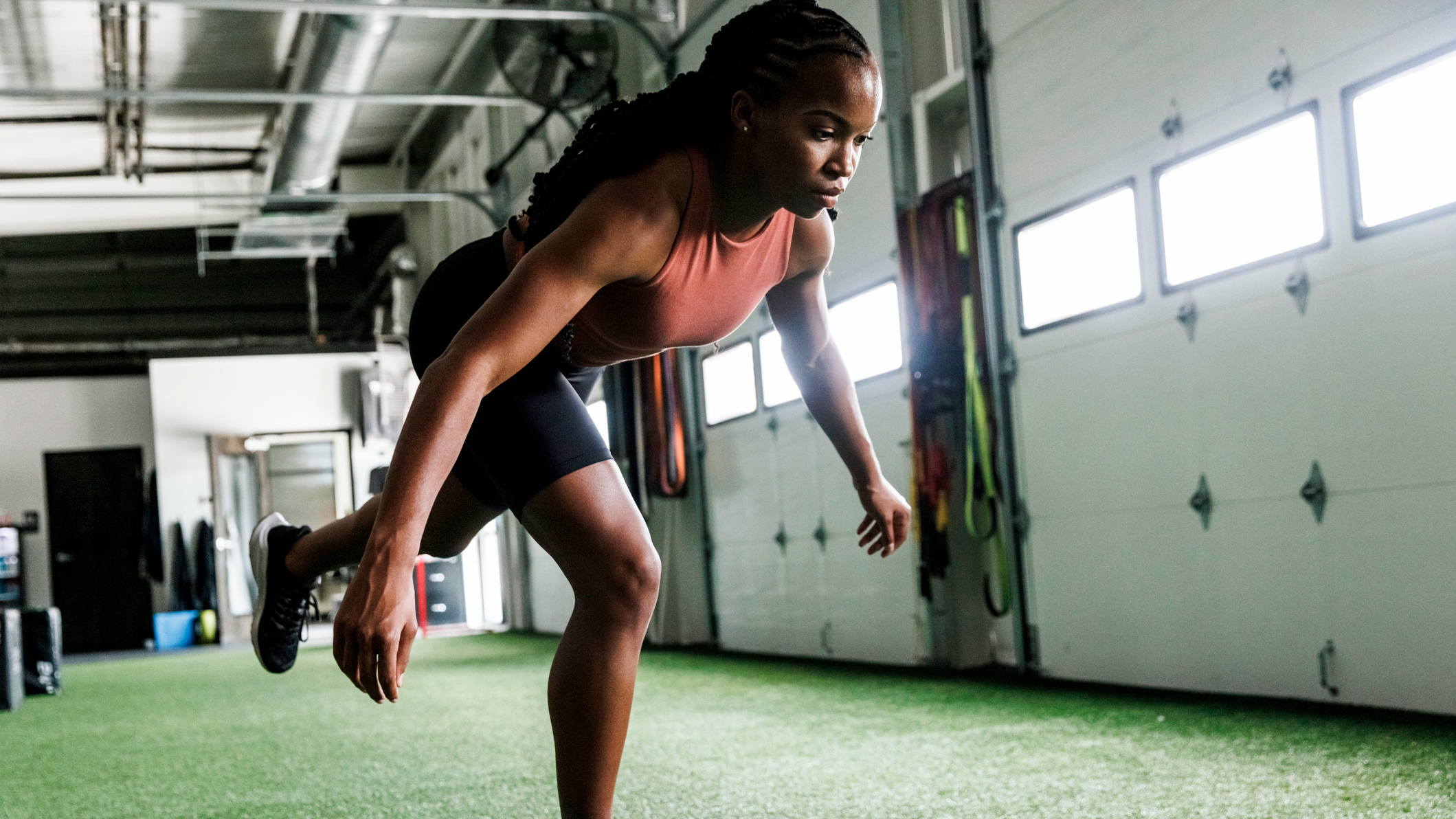
I’m Adding These Five Exercises To My Routine To Improve My Balance
By Alice Porter published
Want to improve your performance at the gym or for sport? Add these bodyweight moves into your workout routine
Get the Coach Newsletter
Sign up for workout ideas, training advice, reviews of the latest gear and more.
